PIARC publications from 2020 - 2023 work cycle
This page presents the technical reports of the 2020-2023 work cycle of PIARC (World Road Association). They are available in one or more of the three working languages of the Association which are French, English and Spanish and have been published after a meticulous validation and quality control exercise.
These reports will be published as they are drafted by our Technical Committees, which work according to the objectives set out in the Strategic Plan 2020 - 2023. Reports from the previous work cycle are already available on this page.
This follows the structure of the 2020 - 2023 Strategic Plan.
- Strategic Theme 1 - Road Administration
- Strategic Theme 2 - Mobility
- Strategic Theme 3 - Safety and Sustainability
- Strategic Theme 4 - Resilient Infrastructure
- Special Projects
- PIARC Technical Reports on the COVID-19 crisis
- Cross-Cutting Committees
PIARC publishes numerous technical reports, which are reference documents that are widely used in the road and transport sectors. They complement other publications of the Association such as the Routes / Roads magazine, Proceedings of international congresses, Proceedings of international seminars and online Manuals.
These technical reports are the output of the work of over 1,000 experts during a four-year work cycle. Their involvement and professionalism must be underlined. They are mobilized within Technical Comittees or Task Forces as defined by the Strategic Plan, which structures the activities of the Association and aims to meet the expectations and needs of road administrations and operators and all members of the Association. These reports thus constitute a wealth of information, made available to all. They offer state of the art international best practices on roads and road transport in a context of integrated and sustainable development.
These technical reports are available free of charge as part of the knowledge sharing and dissemination mission that guides the Association. All language versions are presented simultaneously here, to take into account the reading preferences of each user.
Strategic Theme 1 - Road Administration
TC 1.1 Performance of Transport Administrations
-
It´s All About People – Defining and Promoting Diversity and New Talent Management - Technical Report
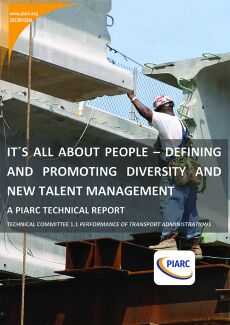
Market dynamics within the transportation sector, and more specifically, emerging and disruptive technological advancements, have necessitated that Transport Administrations critically review how they proactively manage their unique organisational skills and capabilities in order to better serve current and future customer needs. The purpose of this technical report was to investigate how Transport Administrations managed diversity and talent management within their organisations, encompassing [...]
-
Customer Experience and Public Value Creation – Technical Report
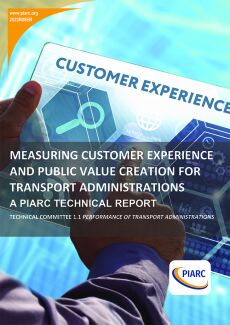
The World Road Association (PIARC) has explored the performance of road and transport administrations focusing on the customer facing levels of service underpinning asset management, models and frameworks in use, how we capture creation of public value and understanding decisions and practices around communicating, engaging and activating the community. This report focusses its research on what approaches are currently happening across the world in respect of delivering an improved experience for [...]
-
The Role of Transport Agencies in Shaping Disruptive Technologies and Service Models – High Impact Summary
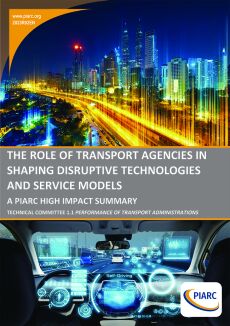
This document is a High Impact Summary of the Final Report on The Role of Transport Agencies in Shaping Disruptive Technologies and Service Models produced by PIARC Technical Committee 1.1 through its Working Group. Under PIARC’s Strategic Plan 2020 - 2023, Technical Committee 1.1 (Performance of Transport Administrations) have sought to research challenges and emerging responses for transport agencies in understanding and successfully shaping disruptive technologies and service models. [...]
-
The Role of Transport Agencies in Shaping Disruptive Technologies and Service Models - Technical Report
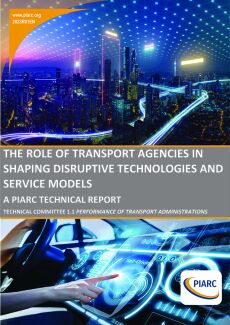
Under PIARC’s Strategic Plan 2020 - 2023, Technical Committee 1.1 (Performance of Transport Administrations) have sought to research challenges and emerging responses for transport agencies in understanding and successfully shaping disruptive technologies and service models. Key technologies within scope include connected, electric and autonomous vehicles, digital highways, new transit modes, micromobility and shared mobility platforms, focused on the following questions: What are the technologies [...]
-
The Role of Transport Agencies in Shaping Disruptive Technologies and Service Models - Case Study Summary Report
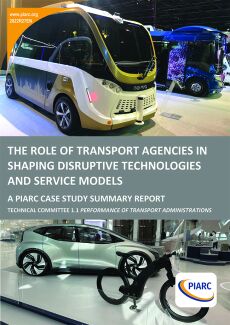
Through its Technical Committee 1.1 Performance of Transport Administrations , PIARC is undertaking an extended investigation of disruptive technologies & service models impacting the roads and transport sector, and how transport agencies are responding to the related challenges and opportunities in policy, regulatory and organisational terms. Key questions being examined by TC 1.1, via its Working Group 2, include: · What are the technologies and service models having the greatest potential [...]
-
Customer Experience -Case Study Analysis
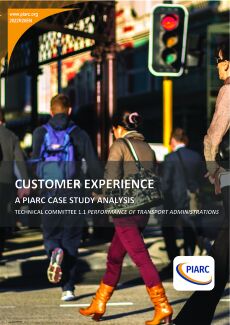
Research continues to show that when public agencies offer a better customer experience, they deliver measurable impacts across multiple priorities. To that end this report focusses its research on what approaches are currently happening across the world in respect of delivering an improved experience for all our customers and stakeholders. It is acknowledged that in many industries, the term “user” designates a person who uses a product or service and the term “customer” refers to a person [...]
-
The Role of Transport Agencies in Shaping Disruptive Technologies and Service Models - A Private Sector Roundtable
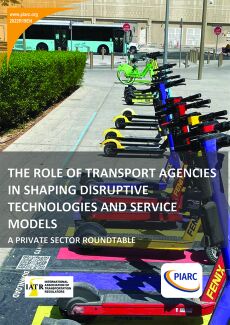
Through its Technical Committee 1.1 Performance of Transport Administrations, PIARC is undertaking an extended investigation of disruptive technologies & service models impacting the roads and transport sector and how transport agencies are responding to the related challenges and opportunities in policy, regulatory, and organisational terms. Key questions being examined by TC 1.1 include: • Which technologies and service models are having the greatest potential impact, in which ways, and [...]
-
The Role of Transport Agencies in Shaping Disruptive Technologies and Service Models - Survey Report
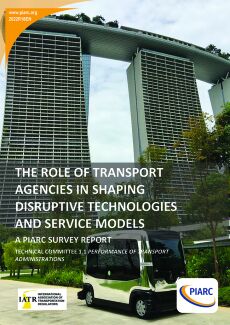
Through its Technical Committee 1.1 Performance of Transport Administrations , PIARC is undertaking an extended investigation of disruptive technologies & service models impacting the roads and transport sector and how transport agencies are responding to the related challenges and opportunities in policy, regulatory and organisational terms. Key questions being examined by TC 1.1 include: Which technologies and service models are having the greatest potential impact, in which ways, and [...]
-
Diversity and Talent Management in Transport Administrations – The Road to Success? - Litterature Review
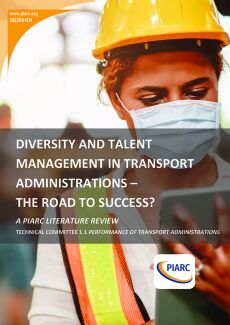
The World Road Association (PIARC) tasked the Technical Committee 1.1 (Performance of Transport Administrations) to analyze effective approaches for defining and promoting Diversity in opportunity across the roads and transportation sectors, and for attracting new talents into the transport industry and in particular Transport Administrations and Road Owners and Operators. Within the frame of this task, Working Group 3 (Organisation of Staff and Human Resources) is working with the objective to [...]
TC 1.2 Road and Transport Planning for Economic and Social Development
TC 1.3 Finance and Procurement
-
Impact of New Propulsion Techniques on Funding Road Infrastructure - Briefing Note
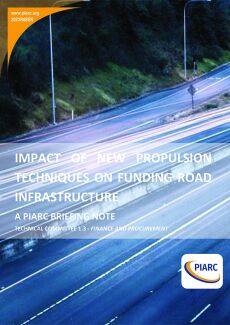
This Briefing Note (BN) analyzes the impacts of modern advancements in vehicle’s propulsion techniques on the funding of road infrastructures at international level, considering the general and progressive shift to alternative fuels for the decarbonization of the road infrastructure and mobility sector worldwide. In particular, the BN explains how, in the next years, probably the evolution of these new propulsion techniques is going to make current traditional fuel taxes (e.g. fossil fuels as [...]
-
Best Practices in Funding and Financing of Road Infrastructure - Collection of Case Studies
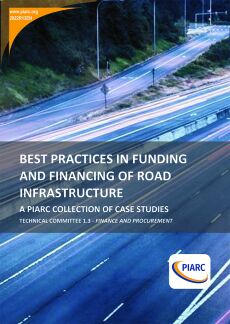
In the past programs, national and international technical committees focused on financing topics related to the design, build, operation and maintenance of road infrastructure, with emphasis placed on relevant elements that could be implemented across the infrastructure management process. Despite this recent international research, many central themes remain to be improved in order to provide discipline to the different interests of public authorities, lenders, private companies and customers. [...]
TC 1.4 Climate Change and Resilience of Road Networks
-
PIARC International Climate Change Adaptation Framework 2023 – Technical Report
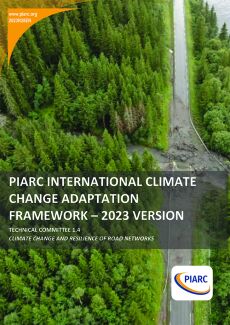
Climate change is a strategic risk to road organisations. Global climate change projections show that there will be gradual changes to average climatic conditions, and changes to the frequency, severity and location of extreme weather events. These climate changes are anticipated to have significant impacts on the design, construction, operation, maintenance and use of global road and transport infrastructure. This is why adaptation principles to address these climate hazard-induced impacts are [...]
-
Uniform and Holistic Approaches to Resilience: Climate Change and Other Hazards - Technical Report
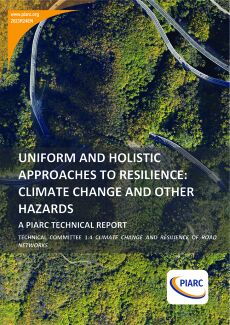
This report focuses on the resilience of road networks in the context of climate change and various hazards, emphasizing the need to consider environmental risks, chronic threats, and acute shocks. Natural hazards are highlighted as a significant global challenge, with extreme weather events and human-induced environmental damage considered the most detrimental threats to road infrastructures. The report calls for urgent attention and strategic planning, strongly encouraging the inclusion of an [...]
-
Climate Change, Resilience and Disaster Management for Roads - Seminar
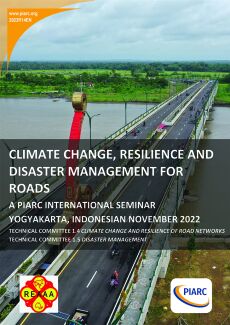
Climate change and other hazards have a wide range of implications on the performance of road infrastructure and can cause disruptions to road network operations. For example, extreme rainfall influences the intensity beyond the drainage capacity of roadways, resulting in slope collapses and landslides as well as traffic disruption. These traffic disruptions will lead to an increase in traffic accidents and restrictions. On the other hand, disasters cause significant loss of life each year throughout [...]
-
Climate Change, Other Hazards and Resilience of Road Networks - Collection of Case Studies
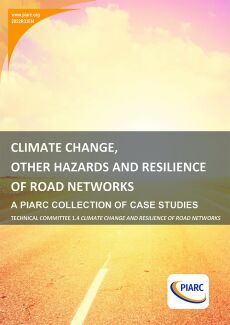
This report contains a collection of case studies related to climate change, other hazards and resilience of road networks. It comprises an introduction, outlining the work program for Technical Committee (TC) 1.4 Climate Change and Resilience of Road Networks, and objectives of two Working Groups within the Technical Committee. These are Working Group 1, which aims to identify uniform and methodological approaches to increasing resilience of roads. It covers hazards and environmental threats within [...]
TC 1.5 Disaster Management
-
The Use of Big Data and Social Networks for Disaster Management - Technical Report
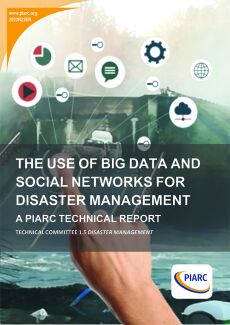
PIARC's Technical Committee 1.5 - Disaster Management, has established a task related to the'Use of Big Data and Social Networks for Disaster Management. This task considers new information evolutions such as big data and social networks. It involves an international literature review, collection and analysis of case studies and engagement with worldwide road administrations to learn from global experience to promote knowledge sharing. As part of this research, TC 1.5 – Working Group 1 (WG1) [...]
-
Financial Aspects of Disaster Management - Technical Report
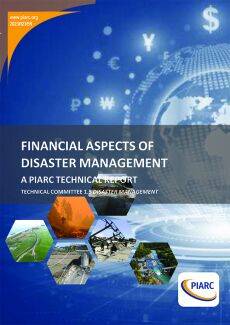
This technical report stems from a collection of case studies pertaining disaster management in different countries of the world; the aim is to analyze the tools and activities that could potentially provide a more integrated and effective financial resource management process during extreme natural events. In fact, many studies have shown how in recent years the severity and frequency of natural disasters has increased and how with it has come an increase in human and economic losses. Recently, [...]
-
Climate Change, Resilience and Disaster Management for Roads - Seminar

Climate change and other hazards have a wide range of implications on the performance of road infrastructure and can cause disruptions to road network operations. For example, extreme rainfall influences the intensity beyond the drainage capacity of roadways, resulting in slope collapses and landslides as well as traffic disruption. These traffic disruptions will lead to an increase in traffic accidents and restrictions. On the other hand, disasters cause significant loss of life each year throughout [...]
-
Road Disaster Management - Using Latest Information Technologies - Briefing Note
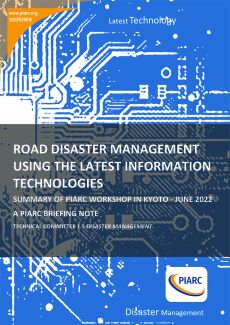
An international workshop was jointly organized by PIARC via its Technical Committee 1.5 “Disaster Management" and the JARA (Japan Road Association). The event was greatly cooperated by REAAA (Regional Association of Asia and Australasia) via its Climate Change, Resilience and Emergency Management Committee. The event was also friendly cooperated by PIARC TC 1.4 (Climate Change and Resilience of Road Networks) and PIARC TC 4.2 (Bridges). This event provides information on the Road disaster management [...]
-
The Use of Big Data and Social Networks for Disaster Management - Briefing Note
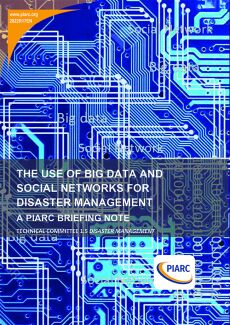
PIARC's Technical Committee 1.5 - Disaster Management, has established a task related to the'Use of Big Data and Social Networks for Disaster Management. This task considers new information evolutions such as big data and social networks. It involves an international literature review, collection and analysis of case studies and engagement with worldwide road administrations to learn from global experience to promote knowledge sharing. As part of this research, an international survey was undertaken [...]
-
A Study on Financial Management of Disasters in the International Arena - Briefing Note
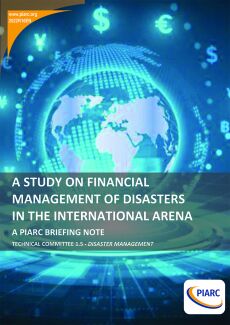
The threats linked to extreme natural events, compromise not only the safety of human life, but also important activities that can move the economy of a country, regardless of its level of wealth. For this reason, the results of this study may be useful not only for high-income countries, but also for LMICs. International survey results suggest the need, for every road administration, to invest in the development of new warning and monitoring systems for widespread phenomena such as floods, heavy [...]
TF 1.1 Well-prepared Projects
-
Well-Prepared Projects
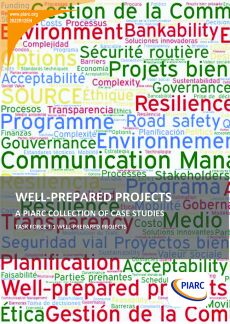
This collection of case studies includes 17 cases from 10 different countries participating in this task force, plus one case dedicated to the use of the SOURCE platform in the preparation of transportation projects. It comes after our first report delivered earlier in 2021 in which we reviewed the overall processes and practices taking place in the 10 countries. The objective of this collection is to provide a variety of highly relevant examples from the real life. Each case outlines good practices [...]
-
How Countries Undertake Well-Prepared Projects: A Review on Ten Countries - Litterature Review
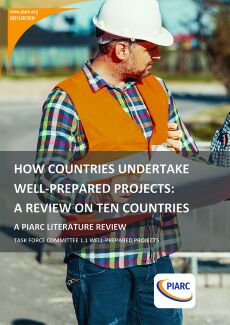
It is well acknowledged that good project preparation tends to deliver better outcomes (benefits) as well as providing good project management performance (with respect to budget, delays and quality). This report presents processes put in place in 10 countries to deliver well-prepared transport projects. This literature review is the first task force deliverable, and it aims to identify good practices found in countries of different income levels and moreover of different cultures. All ten members [...]
T.F.1.2 HDM-4
T.F. 1.3 Well-prepared projects dans low- and middle-income countries
-
Well-Prepared Projects in Low- and Middle-Income Countries - A PIARC Technical Report
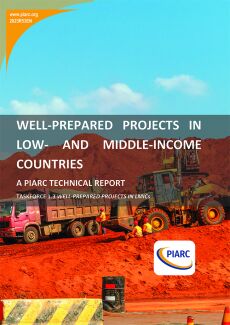
The issue of good preparation of road projects was already dealt with by PIARC Taskforce 1.1 in 2020 and 2021. However, contacts with major organizations concerned, such as Multilateral Development Banks (MDBs), were made difficult during the pandemic. Also, the number of representatives from Low- and Middle-Income Countries (LMICs) in the Taskforce was very limited. These circumstances did not allow the Taskforce to consider the specific case of road projects prepared in LMICs. PIARC therefore [...]
Strategic Theme 2 - Mobility
TC 2.1 Mobility in Urban Areas
-
Multimodal Solutions for Optimizing Road Networks in Urban And Peri-Urban Areas
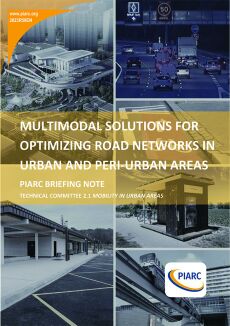
Mobility in urban areas faces complex problems which need to be managed within spatial and budgetary constraints. It is therefore necessary to optimize the use of road networks through better integration with other forms of transport (rail, active modes, etc.). Multimodality giving rise to the concept of " multimodality " . Integrated multimodal transportation systems are large in scale and high in complexity. Their effective, coordinated planning and management is a major challenge [...]
-
Case Studies on Travel Behavior Data Collection in Metropolitan Regions - Briefing Note
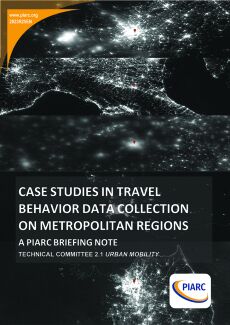
A large number of people have been gathering in and around the cities. Transport infrastructure provision and land-use regulations cause cities to expand towards their outskirts creating urban sprawl and convert rural areas into peri-urban areas. So, understanding how the burden caused by the low-density urban expansion affects the entire metropolitan area is important. We focused on household travel surveys to investigate travel behavior of the residents in the metropolitan areas. It was a time [...]
-
Evaluating Impacts of New Mobility in Urban and Peri-Urban Areas - Collection of case studies
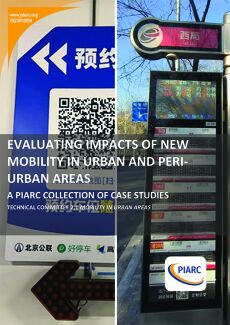
In urban areas, accessing services, education, workplaces and/or goods requires efficient mobility systems. In recent years, various transport technology developments have started to enable more efficient mobility across the world. Innovative transport solutions and sharing contracts, including new technologies, new business models, new types of infrastructure and sharing systems are being developed to maximize the effectiveness of transport systems in urban regions. Through the integration of multiple [...]
-
Multimodal Solutions for Optimizing -Road Networks in Urban and Peri-Urban Areas - Case Studies
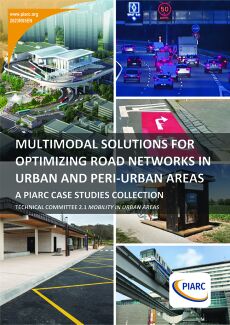
The current collection of case studies is part of a set of six publications of Technical Committee 2.1 Mobility in Urban Areas expected for the 2020-2023 cycle. Mobility in urban areas faces complex problems which need to be managed within spatial and budgetary constraints. It is therefore necessary to optimize road networks through better integration with other forms of transport (rail, active modes, etc.) utilizing a multimodal approach. The Working Group 2 “Integrated transportation [...]
TC 2.2 Accessibility and Mobility in Rural Areas
-
Rural Roads: Pillars of Rural Development - Case Studies
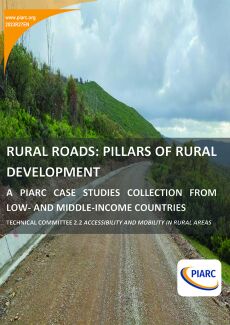
The report "Rural Roads: Pillars of Rural Development - Case Studies in Medium and Low Income African Countries" produced by the World Road Association's Technical Committee 2.2 Rural Accessibility and Mobility , is a relevant study that highlights the crucial importance of rural roads for the development of rural areas in Africa. Focusing on medium- and low-income countries such as Tunisia, Burkina Faso, Morocco, Niger, Côte d'Ivoire and Mali, the report specifically examines the impacts of rural [...]
TC 2.3 Freight
-
Emerging Freight Transport Technologies
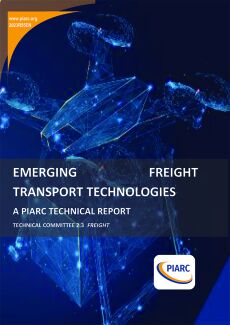
Innovations and advances in emerging freight technologies, such as autonomous trucks, truck platooning, internet of things, robotics, drone deliveries, and digitalization of the freight industry is changing logistics and the management of the freight transport system. These technologies have the potential to increase productivity, efficiency, reliability, flexibility, safety, sustainability, and economic benefits. But substantial work remains to be done to advance these emerging freight transport [...]
-
Super-Single Tires Configuration Overview
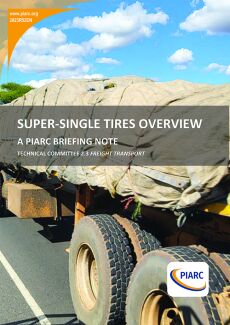
Development of road freight transport is led by economic growth and efficiency. The impact of road freight on infrastructure is very important for road authorities. Physically, the impact on pavement is directly linked to the pressure exerted by vehicle loads, which highly depends on global vehicle weight but also on tires configuration. Looking for more cost-efficient transport, hauliers are looking for trucks that have lower maintenance costs with higher loading capacity. To address this demand, [...]
-
Monitoring and Regulation to Reduce Overloading and Associated Infrastructure Damage on Road Networks - A PIARC Technical Report
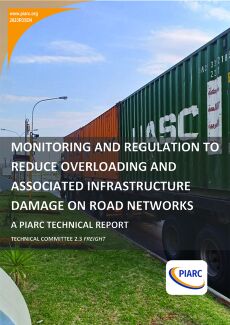
Overloaded trucks, non-compliance or poor vehicle conditions, driver fatigue and speeding remain main challenges in road freight transport, especially in Low-Middle-Income Countries (LMIC). These issues can cause severe road safety problems, substantial damage to the road infrastructure and environmental impacts. Overloading also leads to unfair competition between transport modes and transport companies. This collection gives an overview of some relevant case studies that either rely on long lasting [...]
-
Greening of Freight Transport - Technical Report
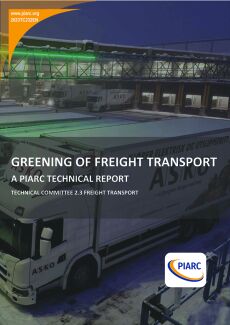
Global warming is a problem we experience every day including rising temperatures, rising water levels, and more frequent extreme weather events. As a major contributor to CO 2 emissions, freight transport must also be a part of the solution. The purpose of this technical report is to highlight policies, initiatives, and projects that are utilized by PIARC member countries to reduce CO 2 emissions from freight transport. Also, pollution and noise are important issues, especially in urban [...]
-
Greening of Freight Transport - Fact Sheets
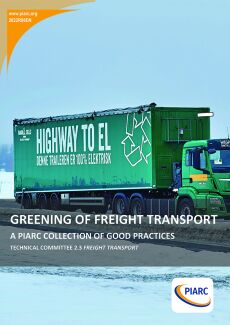
As a major contributor to GHG emissions, freight transport also must be a part of the solution. This topic is evolving rapidly through innovations, new solutions, and experiences and will be of the utmost importance for road managers and public authorities. This document presents a number of good practices. The purpose of these fact sheets is to highlight projects, initiatives and policies that have been utilized by PIARC member countries to make freight transport greener with the goal of reducing [...]
-
Control and Enforcement Measures to Reduce Truck Overloading and Associated Infrastructure Damage on Road Networks - Collection of Case Studies
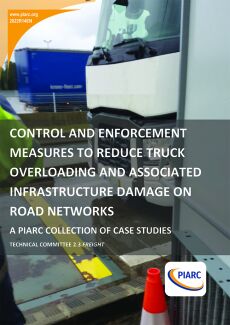
Overloaded trucks, poor vehicle conditions, driver fatigue and speeding remain big challenges in road freight transport for road authorities all over the world. These issues can cause severe road safety problems, substantial damage to the road infrastructure and environmental impacts. Overloading also leads to unfair competition between transport modes and transport companies. Within the Technical Committee 2.3 Freight working group 2.3.1 had a specific focus on monitoring and regulations to [...]
TC 2.4 Road Network Operation / Intelligent Transportation Systems
-
Optimizing Road Network Operations Using Big Data - Technical Report
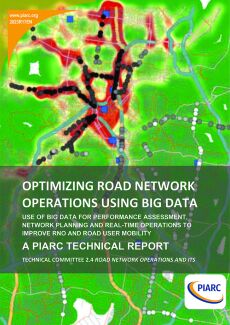
Road network operators are increasingly embracing technology and developing digital infrastructure to effectively manage road networks. At the same time, road users are using technology to enhance trip efficiency and safety, while vehicles on the road network are utilizing an increasing amount of technology to manage fleets, improve safety, and move toward automated operations. These trends have led to an increase in available data for road network operators, which can support improved decision-making. [...]
-
Utilizing Data to Optimize Road Network Operations - Collection of Case Studies
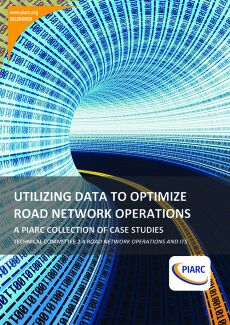
Road network operators are increasingly making use of technology and developing digital infrastructure to manage road networks. Road users are making use of technology to efficiently and safely complete trips. Vehicle manufacturers and fleet managers are utilizing an increasing amount of technology to manage fleets, improve safety, and advance toward automated operations. Sensor and data analytics technologies are continuing to increase in capability. All of these trends are increasing the amount [...]
TF 2.1 New Mobility and its Impact on Road infrastructure and Transport
-
New Mobility and Road Infrastructure
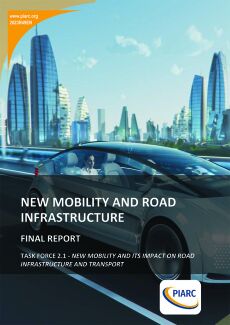
PIARC has been concerned, for some time, about the challenges and opportunities presented by Connected and Autonomous Vehicles for Road Network Operators. These were explored by two Task Forces between 2018 and 2020, and the rapid and disruptive arrival of a wider range of mobility technologies, digital and service concepts required a review and update. The new forms of mobility refer both to the new vehicle types and technologies that are beginning to circulate on streets and highways, as [...]
-
New Mobility And Road Infrastructure - A PIARC Technical Report
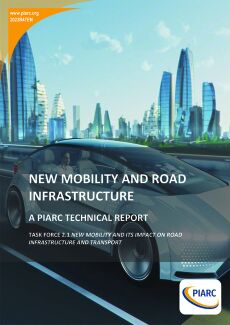
PIARC has been concerned, for some time, about the challenges and opportunities presented by Connected and Autonomous Vehicles for Road Network Operators. These were explored by two Task Forces (B.1 and B.2) between 2018 and 2020 but have now been overtaken by the rapid and disruptive development of a wider range of technologies, digital tools and mobility services. The new forms of mobility comprise the new types of vehicle and technologies that are starting to appear on streets and highways, [...]
-
New Mobility and Road Infrastructure - Interim Report
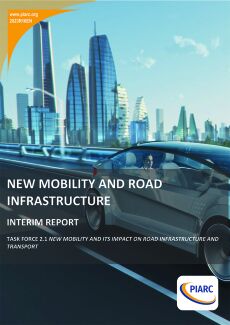
PIARC has been concerned, for some time, about the challenges and opportunities presented by Connected and Autonomous Vehicles for Road Network Operators. These were explored by two Task Forces (B.1 and B.2) between 2018 and 2020 but have also now been overtaken by the rapid and disruptive development of a wider range of new mobility technologies, digital and service concepts. The new forms of mobility refer both to the new vehicle types and technologies that are starting to circulate on streets [...]
TF 2.2 Electric Road Systems (ERS)
-
Electric Road Systems – A Route to Net Zero - Technical Report
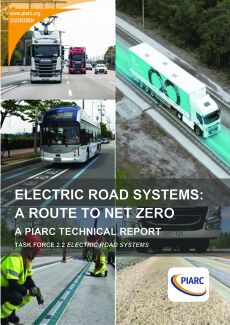
The international Paris Agreement about climate change calls for action in every aspect of the modern society. The world’s road transport sector is responsible for a considerable amount of the total CO₂ emissions, so there is an urgent need for decarbonising the road transport sector. To achieve the Paris Agreement, the road transport sector needs to work with many solutions. For example, battery electric solutions, biofuels, fuel cells/hydrogen and Electric Road Systems (ERS). ERS are systems [...]
-
Electric Road Systems - Collection of Case Studies
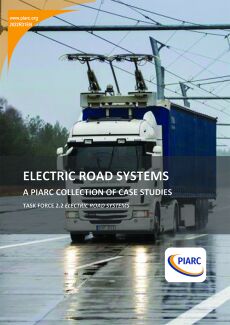
The collection of case studies report on electric road systems (ERS) provides an overview of the activities of PIARC Task Force 2.2 to date. This includes an overview of the tasks and activities of the Task Force as well as the progress made to date in terms of collection and review of literature, collection of case studies, survey questionnaire development and workshops. The report ends with a brief conclusion regarding the progress to date and information regarding the immediate next steps that [...]
TF B.2 Automated Vehicles – Challenges and Opportunities for Road Operators and Authorities
-
Automated Vehicles - Challenges and Opportunities for Road Operators and Road Authorities - Technical Report
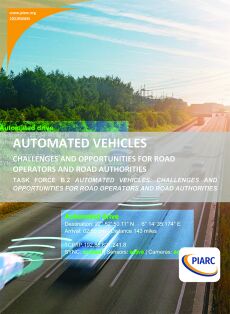
Vehicle Automation – at SAE levels 3, 4 and 5 – is still in a testing phase in most countries. Many tests at level 3 have been performed successfully on open roads without any changes to the road infrastructure and without any observed impacts on congestion. There are various situations which necessitate that a driver takes control of the vehicle – a fall-back solution that is still allowed at level 3, but not at level 4 or 5. It is likely that some support from the infrastructure will be [...]
Strategic Theme 3 - Safety and Sustainability
TC 3.1 Road Safety
-
Road Safety Audits Guidelines for Road Projects - A PIARC Technical Report
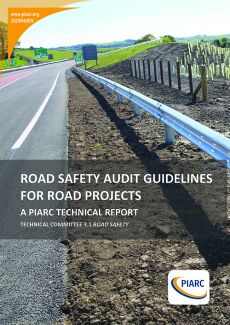
New road projects are constantly being planned and implemented that do not fully exploit the possibility to improve road safety by better design. This can be because there is either a lack of knowledge and understanding of the fundamental issues or as a result of having to balance the various, often competing, interests involved. Transport efficiencies and requirements and economics of the project are often given highest priority, followed by environmental considerations, with safety being considered [...]
-
Saving Lives Around the World With Proven Countermeasures - Technical Report
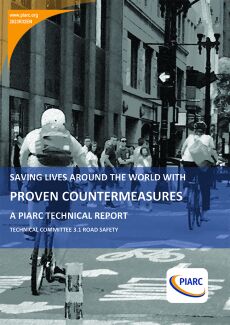
Saving Lives Around the World With Proven Countermeasures - Technical Report
-
Specific Road Safety Issues for LMICs: Illustrative Examples - Collection of Case Studies
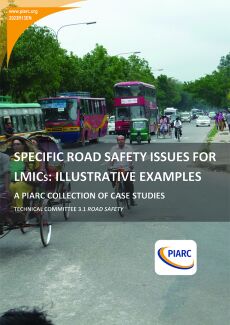
The overview of illustrative examples of road safety measures in LMICs as described in this report is a follow up of an earlier literature review, in which we indicated which specific issues do need further attention in LMICs in the coming period up to 2030. The following issues were considered: I. SDG’s: integral approach II. Road safety culture III. Road safety management and leadership IV. Building road safety expertise and science V. The transportation system as a whole [...]
-
Road Safety in LMICs: Identification and Analysis of Specific Issues - Literature Review
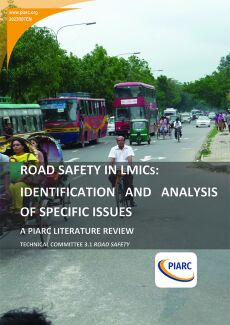
This report is a deliverable of PIARC working group 3.1.1 Specific road safety issues for LMICs. The working group performed its activities in the period 2019 – 2023. We prepared two deliverables: a) a literature review and b) an overview of case studies. The present report gives the literature review. The review starts from the notion that road safety is a multifaceted problem which requires a multi-disciplinary approach. The safe system approach is generally considered as the central concept [...]
TC 3.2 Winter Service
-
Integration of New Technologies in Winter Service - A PIARC Technical Report
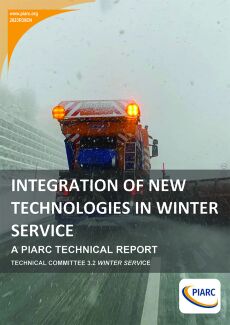
The purpose of the technical committee PIARC is to share knowledge. The technical committee Winter Service has been handling new approaches that can help perform road maintenance in winter conditions more effectively, environment friendly and with focus on users’ needs. In the cycle 2012-2015 the final report “ADVANCED TECHNOLOGY FOR DATA COLLECTION AND INFORMATION TO USERS AND OPERATORS” was devoted to mutual communication and its further development. The next cycle ended 2015-2019 brought [...]
-
Survey on Winter Maintenance in the City - Collection of Case Studies
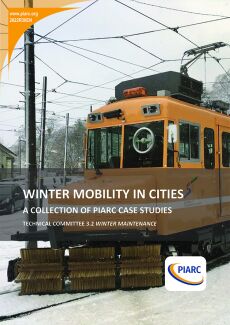
While winter maintenance in rural areas is a relatively well-known topic, it is less so in urban areas, although there are more and more presentations on this topic at PIARC winter maintenance conferences and a specific winter maintenance theme is proposed. Compared to rural roads, winter maintenance in cities is different in many ways. Different modes of transportation, lack of space for snow, often very narrow roads, and development make winter maintenance planning complex. The many responsible [...]
-
Snow And Ice Databook 2022 - Technical Report
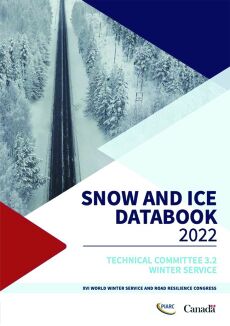
Winter service is the fight against snow and ice on roads to ensure accessablity and traffic safety. One needs to get to work from home, children need to get to school and with very tight procution plans, goods need to arrive in time for the whole process to work. Unpassable roads due to snow and ice would have dramatic effets on all of us as we relate on safe roads. No winter is like the other, weather can change rapidly and can´t be forecasted over longer periodes. Consequently, winter maintenance [...]
TC 3.3 Asset Management
-
Guidelines for the Implementation of ISO 55001 in Road Organizations
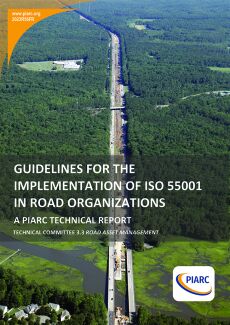
“Asset Management” as defined in ISO standards 55001, aims to enable an organization to obtain value from assets. ISO 55001 offers a structured approach to asset management by focusing on implementation of “risk-based, information-driven, planning and decision-making processes and activities that transform organizational objectives into asset management plans”. To obtain the highest profitability and perform the best possible management of an asset throughout its useful life, from its construction [...]
-
Life Cycle and Risk Management
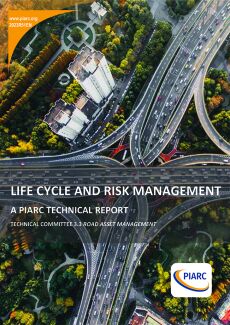
Asset Management enables organizations to derive value from their assets. It emphasizes a structured approach through risk-based, information-driven planning and decision-making, transforming organizational objectives into actionable asset management plans. A life cycle plan is essential for maximizing profitability and managing an asset effectively from construction to disposal. Lifecycle planning maintains an asset from construction to disposal, predicting future performance based on investment [...]
-
BIM and Digitalization in Road Asset Management
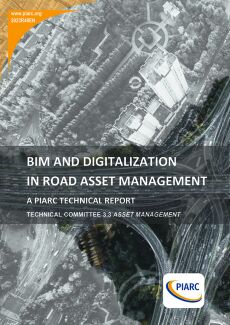
The objective of the work carried out by WG 1 within the field of BIM and Digitalization has been fundamentally to carry out an analysis of the state of the art worldwide of how Digitalization is being applied in Road Asset Management and the BIM methodology. within the same area. From the content of the document, it can be deduced how the level of digitalization in Road Asset Management has reached a high level of technology, however, from what the reader of this report can deduce, there is [...]
-
Measures for Improving Resilience of Road Network - Technical Report
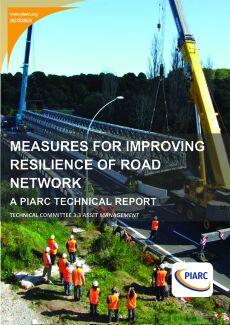
Transportation infrastructure is vulnerable to threats such are natural and man-made hazards and each agency needs to improve their own ability to adequately and decisively respond to sudden and unforeseen challenges to infrastructure performance. It is pivotal for countries to learn from past experiences to form a shared view on possible future development of transportation networks and how to improve current management approaches to be flexible and adaptive to address future threats, which are [...]
-
Renewal and Rejuvenation of Aging Infrastructure - Technical Report
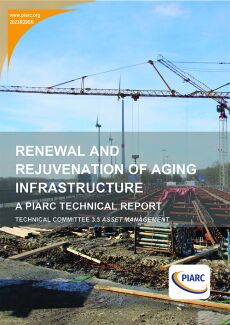
For the purpose of this research, “aging infrastructure” is defined as any road related assets that are approaching the end of their expected service life or have prematurely deteriorated in condition and are no longer providing the required level of service. This may be due to shorter service life due to assets not performing as expected, changing usage of the network, changing environment since design and construction of assets, and / or underinvestment in maintenance that has created a backlog [...]
TC 3.4 Environmental Sustainability in Road Infrastructure and Transport
-
Mainstreaming Biodiversity within Road Infrastructure Projects - A PIARC Collection of Case Studies
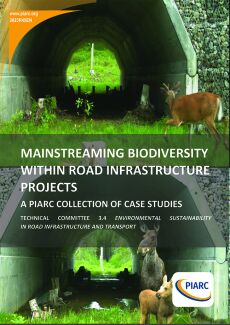
This document is an appendix to the Full Report 2023R44EN, and it contains the Case Studies collected by the WG3.4.3 team; the chapters listed here are those that structure the Full Report. The case studies illustrate the theoretical elements written in the Full Report. The development of transport infrastructure is one of the basic elements of the development of countries and their economies. Economic development is often accompanied by environmental protection problems, including biodiversity [...]
-
Mainstreaming Biodiversity within Road Infrastructure Projects - A PIARC Technical Report
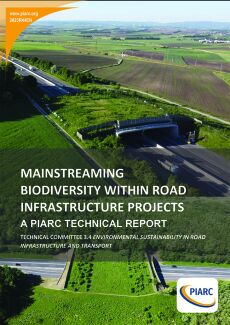
The development of transport infrastructure is one of the basic elements of the development of countries and their economies. Economic development is often accompanied by environmental protection problems, including biodiversity impacts, because they have not been taken enough into account. Preventing land fragmentation, preserving biodiversity and continuity of ecological corridors is one of the most important challenges for transport infrastructure stakeholders. The report is a global guide for [...]
-
Low Emission Zones – Planning and Implementation - A PIARC Briefing Note
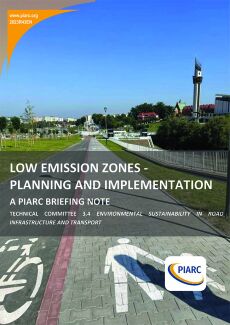
Air pollution problems are often observed in the roadside areas of metropolitan regions, where a lot of emission sources such as factories, business offices, residential houses and vehicles accumulate. Increasing congestion in cities with no or limited restrictions on driving in urban areas is contributing to a number of social- and health-related problems. Many countries are considering various types of restrictions on car traffic – especially in urban centers. The fastest-growing scheme since [...]
-
Near Road Air Quality - A PIARC Briefing Note
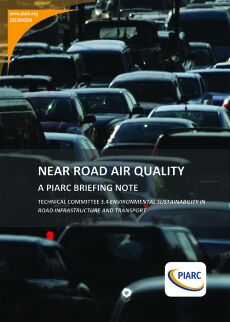
“Air pollution problems are often observed in the roadside areas of metropolitan regions, where a lot of emission sources such as factories, business offices, residential houses and vehicles accumulate. Such air pollutions are caused by emissions of SO2, NO2, CO, HC, PM10, PM2.5 etc. which are designated as air pollutants in most countries across the world. In order to carry out air pollution abatement measures, we have long-term evaluation values and short-term evaluation values as regulation [...]
TF 3.1 Road Infrastructure and Transport Security
-
Road Infrastructure And Transportation Security - A PIARC Technical Report
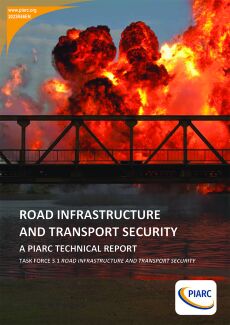
This report aims to provide elements for addressing security risks and risk management from criminal and terrorist threats in the various road topics affecting road infrastructure mentioned above, within the conceptual framework, definitions and terminologies provided by the international standards ISO 28000 and 31000. Among the techniques that can be used, risk assessment was chosen which includes risk identification, analysis and assessment phases, and selecting a consequence/liability pair and [...]
-
Documents Relevant to Road Infrastracture and Transportation Security - Literature Review
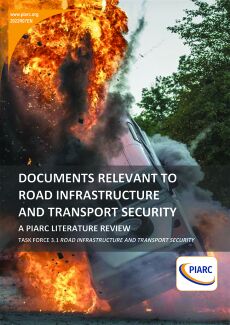
This document contains a review of literature on road infrastructure and transport security. The review focuses on the following topics: · Legislations and policies; · Standards; · Studies and researches; · PIARC reports; · Other reports; · Manuals and books; · Case studies and best practices; · Events and situations. This document is completed with conclusions and recommendations, a glossary and appendices. This Literature Review is the first step in the development [...]
Strategic Theme 4 - Resilient Infrastructure
TC 4.1 Pavements
-
Measures for improving resilience of pavements - Technical Report
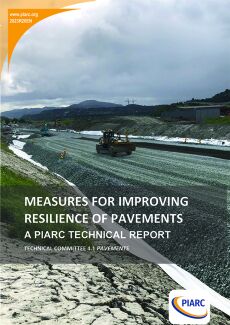
This report discusses resilience in pavements with regard to various vulnerability issues resulting from disruptions or hazards due to climate change, vehicular traffic, and natural and human-caused disasters. For the purpose of this report, resilience is approached from a “bottom up” or object level perspective. The possible impacts of the three categories of pavement stressors mentioned above—climate change, vehicular traffic, and natural and human-caused disasters—are described. Several [...]
-
The Use of Big Data for Road Condition Monitoring - Briefing Note
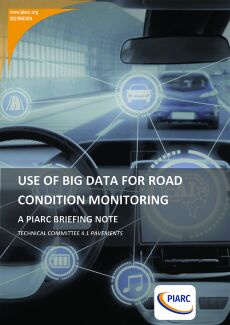
This briefing note provides an overview of numerous big data sources and the data-processing methods that can be used to analyse data for road condition monitoring. It focuses on solutions that allow data to be collected quickly, in real time and repeatedly, e.g. via CAN bus, smartphones, digital imagery, open data, crowdsourced data, satellites etc. Whilst most of these methods and technologies have been in existence for some time, it is only relatively recently that their potential for road condition [...]
-
The Use of Big Data for Road Condition Monitoring - Literature Review
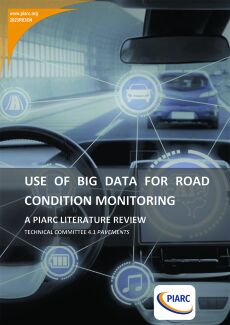
This literature review provides an overview of numerous big data sources and the data-processing methods that can be used to analyse data for road condition monitoring. It focuses on solutions that allow data to be collected quickly, in real time and repeatedly, e.g. via CAN bus, smartphones, digital imagery, open data, crowdsourced data, satellites etc. Whilst most of these methods and technologies have been in existence for some time, it is only relatively recently that their potential for road [...]
-
Innovative Pavement Maintenance and Repair Strategies - Collection of Case Studies
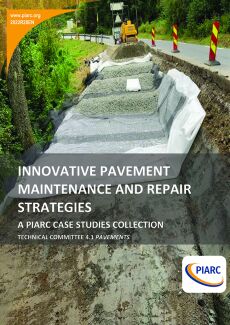
This report contains the collection of case studies related to innovative pavement maintenance and repair strategies of road pavements. This report addresses different pavement types i.e. flexible and (semi-)rigid pavements - as well as different road types. It considers both functional and structural aspects. The report covers innovation aspects on a technical level, such as the use of special or innovative materials, or the use of specific maintenance techniques, as well as innovative and strategic [...]
-
Measures for Improving Resilience of Pavements - Collection of Case Studies
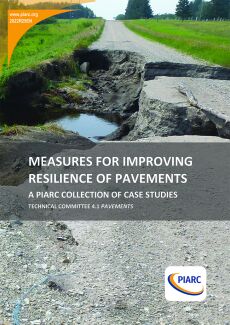
This report contains a collection of case studies related to measures to improve the resilience of pavements. Most of the measures address the impacts of climate change, such as increased precipitation and extreme temperatures. However, the case studies also explore how to make pavement more resilient to traffic-related impacts, including through the use of innovative materials. The full report on “Measures for improving resilience of pavements” by TC 4.1 Pavements will refer to these case [...]
-
Use Of Recycled Materials In Pavements - Briefing Note
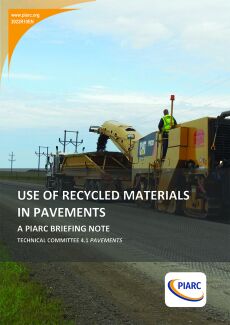
Back in 2003, PIARC published a report from Technical Committee C7/8 on “Pavement Recycling”. This report contains guidelines for in-place recycling with cement, emulsion or foamed bitumen and hot mix recycling in a plant. The current briefing note is the final part of a set of three reports on the “Use of Recycled Materials in Pavements”. This briefing note contains the conclusions and recommendations on recycling pavement materials deriving from the previous “Literature Review” and [...]
-
Use of Recycled Materials in Pavements - Case studies
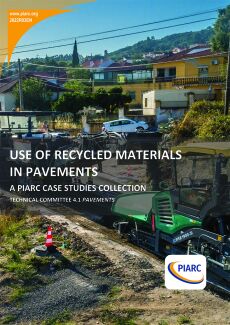
This report contains the collection of case studies related to in-place recycling with cement, emulsion or foamed bitumen, hot mix and cement concrete recycling in a plant. The current collection of case studies is part of a set of three publications on the “Use of Recycled Materials in Pavements” expected for the 2020-2023 cycle. This collection reports case studies on: ● recycling in-place using hydraulic and/or bituminous binders, it also addresses the preliminary investigations of [...]
-
Reducing the Life Cycle Carbon Footprint of Pavements - High Impact Summary
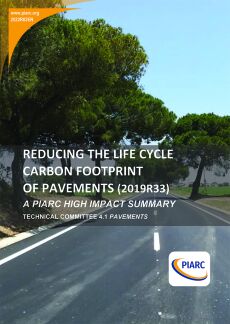
In 2019 PIARC published the report “Reducing the life cycle Carbon Footprint of pavements” (2019R33), which was a result from the work conducted by the Technical Committee D.2 – Pavements, during the 2012-2015 cycle. This report assessed and synthesized recent innovations leading to the reduction of Carbon Footprint of pavements. It also presented a critical review of the Carbon Footprint reductions achieved by various innovative technologies when compared to standard methods of construction [...]
-
Use of Recycled Materials in Pavements - Literature review
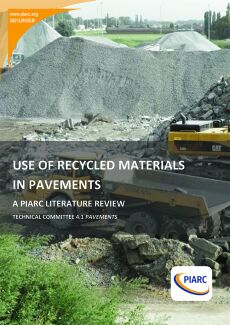
Back in 2003, PIARC published a report from Technical Committee C7/8 on “Pavement Recycling”. This report contains guidelines for in-place recycling with cement, emulsion or foamed bitumen and hot mix recycling in a plant. The current literature review is part of a set of three publications on the “Use of Recycled Materials in Pavements” expected for the 2020-2023 cycle. This literature review describes: recycling in-place using hydraulic and/or bituminous binders, it also addresses [...]
TC 4.2 Bridges
-
Advancement of Inspection Techniques / Technologies as a part of Bridge Management Systems - PIARC Technical Report
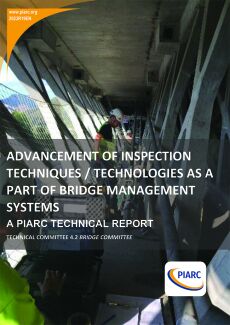
New techniques and technologies are constantly emerging and changing that affect our lives in many ways.For example, advances in communication via online tools enable us to do our work even in times of a pandemic. When it comes to bridge inspection as part of a holistic bridge management system, new tools resulting from technological advancements allow engineers to improve their work by getting a better picture of the current condition of a bridge. Innovative inspection techniques and technologies [...]
-
Forensic Engineering for Structural Failures - Technical Report
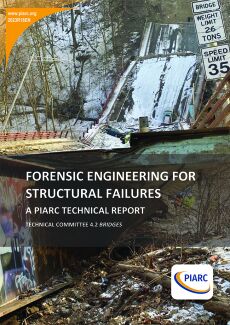
When a bridge collapse occurs, engineers investigate the cause of collapse to identify how design, materials, workmanship, and/or overloading affected structural performance. In this meaning, forensic engineering plays an important role in improving the safety of bridges. Engineers learn from the results of forensic engineering investigations and make improvements to the requirements of design, construction, and maintenance in order to prevent these tragedies from reoccurring. As a result, there [...]
-
New Rehabilitation Materials and Technologies for Road Bridges - Briefing Note
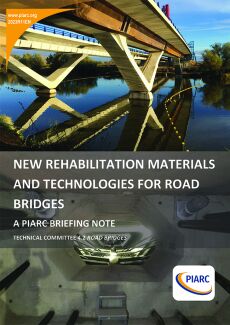
Every country around the world needs to manage and to rehabilitate his bridge stock. The latter may be old (for example about 60 years or more in Europe) or very young (about 10 years for example in new high-income countries). Therefore, the needs for rehabilitation of an aging bridge stock may be different from one country to the other. Even if the aging of bridges is the main cause of rehabilitation, a bridge owner may also need to adapt existing bridges to increase it service level (number [...]
-
Measures for Increasing the Adaptability of Road Bridges to Climate Change - Technical Report
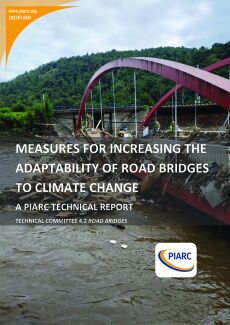
There are already signs of climate change driven extreme weather events in certain parts of the world including heavy rain, flooding, tropical storms, drought, high temperatures and so on. The frequencies of some of these events are also increasing. In general, there are extreme natural events being experienced in many countries resulting in loss of lives and loss or damage to infrastructure. Climate change has become a global issue of concern and it is for this reason that PIARC has incorporated [...]
-
Damage-Resilient Bridges in Seismic Areas - Technical Report
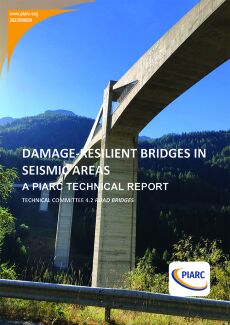
Resilient Infrastructure is the fourth Strategic Theme defined by PIARC in the 2020-2023 Strategic Plan. During this cycle, Technical Committee 4.2 Road Bridges was assigned 5 issues. The fifth issue, titled “Damage-Resilient Bridges in Seismic Areas”, was consistent with the fourth Strategic Theme, and was addressed by preparing two deliverables : a collection of case studies and a full report. The collection of case studies provided information given by stakeholders worldwide regarding: [...]
-
Damage-Resilient Bridges in Seismic Areas - Collection of Case Studies
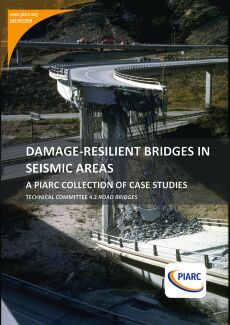
Resilient Infrastructure is the fourth Strategic Theme defined by PIARC in the 2020-2023 Strategic Plan. During this cycle, Technical Committee 4.2 Road Bridges was assigned 5 issues. The fifth issue, titled “Damage-Resilient Bridges in Seismic Areas”, was consistent with the fourth Strategic Theme, and was addressed by preparing two deliverables; (1) a collection of case studies and (2) a final report. This document, the collection of case studies, is a compilation of information collected [...]
-
Measures for Increasing the Adaptability of Road Bridges to Climate Change - Literature Review
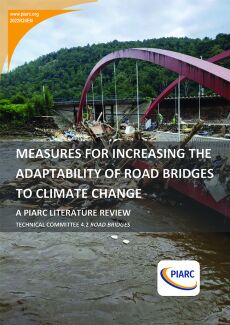
The IPCC (Intergovernmental Panel on Climate Change) Working Group 2 report states that changes in climate have caused impacts on natural and human systems on all continents and across the oceans. Key risks from climate change are typically defined as warming trend, extreme temperature, precipitation, extreme precipitation, drying trend, and sea level rise. The impacts of climate change will be regional and depend on the level of adaptation and mitigation achievable. Transportation infrastructure [...]
-
Road Bridges - New Rehabilitation Materials and Technologies - Technical Report
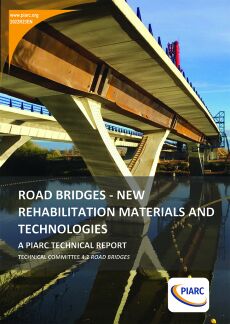
Every country around the world need to manage and to rehabilitate his bridge stock. The latter may be old (for example about 60 years or more in Europe) or very young (about 15 years for example in new high-income countries but not only). Therefore, the needs for rehabilitation of an aging bridge stock may be different from one country to the other. The aging of bridges is one of the main cause of rehabilitation, but not only. Extreme events related or not to climate change are also an important [...]
-
Advancement of Inspection Techniques / Technologies as a Part of Bridge Management Systems - Collection of Study Cases
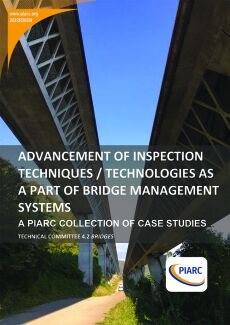
Bridge inspections form an essential basis for the maintenance management of bridges and engineering structures. New technologies such as remote sensing and the use of a variety of sensors have the potential to significantly improve the quality of the results of structural inspections, but due to a lack of experience on the part of owners and operators they are not yet being used comprehensively. In order to make these technologies more readily available, Working Group 2 of the Technical Committee [...]
TC 4.3 Earthworks
-
Increasing Resilience of Earth Structures to Natural Hazards
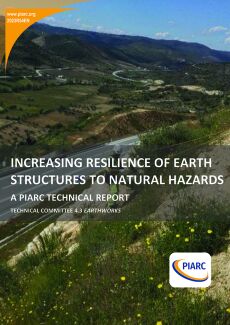
This report provides a complete background on the topic of “Increasing Resilience of Earth Structures to Natural Hazards” assigned to WG1 of PIARC TC 4.3 as part of the 2020-2023 Work Program. This topic has been developed as part of the 2020-2023 Work Cycle and is complemented by two additional documents for this topic: a Case Studies Report and a Literature Review Report. The production of this report was carried out in multiple phases. The first phase involved a cursory review and selection [...]
-
Innovations and Techniques - Application to Earth Structures in the Future - A PIARC technical Report
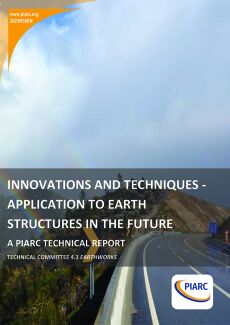
As we move further into the 21st century, it is becoming increasingly more clear that climate change is the biggest concern that we must face. The effects of climate change, specifically the increasing frequency and intensity of natural hazards, are wreaking havoc on infrastructure, including earth structures, around the globe. The need for more resilient earth structures requires firm and bold action by owners, managers, stakeholders and the whole scientific community. The purpose of this report [...]
-
Resilience of Earth Structures - Collection of Case Studies
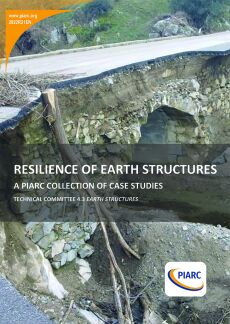
This case study compilation tries to give a deeper insight on the topic “Increasing Resilience of Earth Structures to Natural Hazards” assigned to WG1 of PIARC TC 4.3 as part of the 2020-2023 Work Programme. For the production of this report, relevant case studies related to resilience in earth structures have been requested from all the members of PIARC TC 4.3 and also from non-PIARC experts. The case studies that have been submitted give an idea of what the academic and technical community [...]
-
Techniques and Innovations in Earthworks - Collection of Case Studies
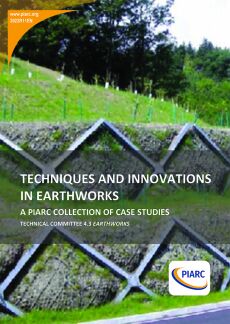
This report presents the summary of thirty-six cases studies compiled by Working Group 2 of Technical Committee 4.3 under the theme “Techniques and Innovations in Earthworks“. This document will be further developed as part of the 2020-2023 Work Cycle and is expected to be accompanied by one additional document in publication, a full report. The information contained herein provides general insight, innovative techniques, and unique solutions to problems related to earthworks and earth structures [...]
-
Increasing Resilience of Earth Structures to Natural Hazards - Litterature Review
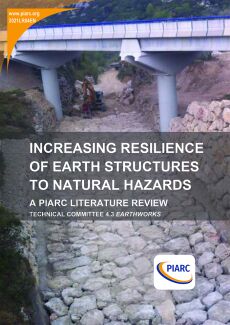
This report provides preliminary background on the topic of “Increasing Resilience of Earth Structures to Natural Hazards” assigned to WG1 of PIARC TC 4.3 as part of the 2020-2023 Work Program. This topic will be further developed as part of the 2020-2023 Work Cycle and is expected to be completed by two adittional documents for this topic: a Case Studies Report and a Full Report. This Literature Review provides general insight on how the concept of resilience is currently being considered among [...]
TC 4.4 Tunnels
-
Impact of New Propulsion Technologies on Road Tunnel Operations and Safety - A PIARC Technical Report
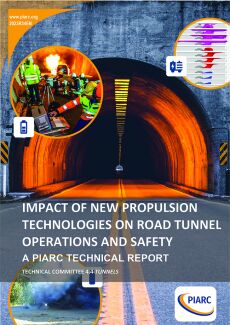
Alternative propulsion technologies, including battery-electric vehicles, are becoming more prevalent. Whilst such vehicles remain a small overall proportion of the vehicle fleet, the combination of impacts of Government policy and technological advances in alternative fuels is expected to accelerate their increase in numbers on the road and in tunnels in coming years. There may also be particular initiatives in certain geographical areas, such as on airport land for example, where higher proportions [...]
-
Improving Road Tunnel Resilience, Considering Safety and Availability - Technical Report
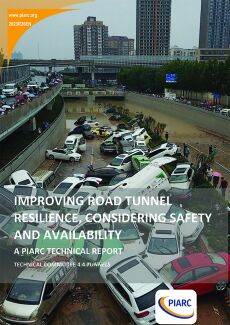
This report presents a road map to improve the resilience of road tunnels, based on a literature review, a collection of case studies and the knowledge and experience of the members of Working Group 2 “Safety and Resilience” of PIARC Technical Committee 4.4 “Tunnels”. The content of the report is addressed at several target groups involved in the planning, design, implementation, operation, maintenance and refurbishment of road tunnels, such as decision makers, tunnel owners and managers, [...]
-
Good Practices in Maintenance and Traffic Operation of Heavily Trafficked Urban Road Tunnels - Technical Report
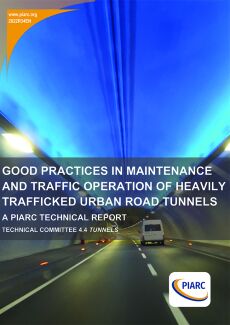
Maintenance and operation of heavily trafficked urban road tunnels is one of, if not the most outstanding challenge for authorities, owners, operators and designers of tunnels. This full report makes amends in detailing the challenges and inherent good practices for maintenance and operation from traffic management, to design and renovation. This full report was cowritten by a panel of designers, owners, operators, policy makers in the field of tunnels, from around the world, taking inspiration [...]
-
Good Practices in Maintenance and Traffic Operation of Heavily Trafficked Urban Road Tunnels - Collection of Case Studies
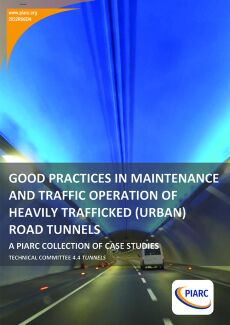
The aim of the case study collection report is to gather, evaluate and comment on international expertise related to maintenance and traffic management in highly trafficked urban road tunnels. A large number of cases were collected, which were particularly suitable for providing an insight into the implementation of these special requirements for urban road tunnels. It became apparent that it was useful to divide the cases into 3 categories, which pursued similar goals. · Implementation of [...]
-
Impact of New Propulsion Technologies on Road Tunnel Operations and Safety - Literature review
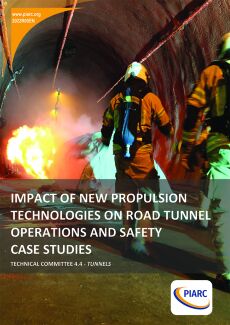
Alternative propulsion technologies, including battery-electric vehicles, are becoming more prevalent. Whilst such vehicles remain a small overall proportion of the vehicle fleet, the combination of impacts of Government policy and technological advances in alternative fuels is expected to accelerate their increase in numbers on the road and in tunnels in coming years. There may also be particular initiatives in certain geographical areas, such as on airport land for example, where higher proportions [...]
-
Improving Road Tunnel Resilience, Considering Safety and Availability - Literature Review
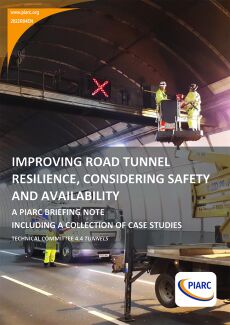
This report presents a review of literature on the improvement of road tunnel resilience as well as a collection of case studies that illustrate how this topic is being dealt with in practice. The content of the report is addressed at several target groups involved in the planning, design, implementation, operation, maintenance and refurbishment of road tunnels, such as decision makers, tunnel owners and managers, tunnel operators, emergency response services, designers, tunnel safety experts, safety [...]
-
Improving Road Tunnel Resilience, Considering Safety and Availability - Literature Review
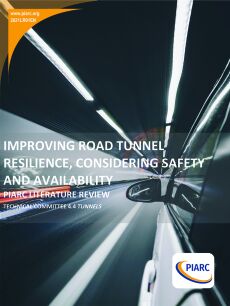
This report contains a review of literature on road tunnel resilience, including more general literature on resilience principles or aspects that could be applied to tunnels. Many definitions for “resilience” were found, but the Working Group decided on the following definition in the context of tunnels: “The ability to prepare and plan for, absorb, recover from, or more successfully adapt to actual or potential negative effects of events or developments affecting the availability of a road [...]
TF 4.1 Road Design Standards
-
Models for Sight Distance in Road Design - A Worldwide Comparison of Standards - A PIARC Technical Report
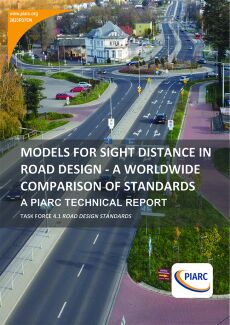
This report is the second of two planned publications of PIARC Task Force 4.1 “Road Design Standards” in the period 2020 – 2023. PIARC considered the importance of comparing international road design standards to check their updated status and the degree of their readiness to face the forthcoming innovations in road mobility. The full report presents a review of selected models in the field of road design standards based on a literature review, which was the first publication of PIARC TASK [...]
-
State of the Art in Road Design Standards - Literature Review
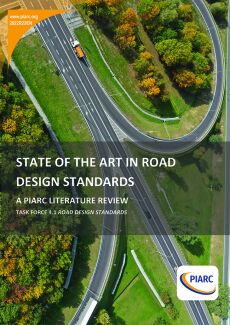
This literature review is the first of two planned publications of PIARC Task Force 4.1 “Road Design Standards” in the period 2020 – 2022. PIARC considered importance of comparison international road design standards to check their updated status and the degree of their readiness to face the forthcoming innovations in the road mobility. The report presents a literature review in the field of road design standards based on reviewing reports, guidelines, and research papers on the subject matter. [...]
Special Projects
-
Social Equity and Social Accessibility
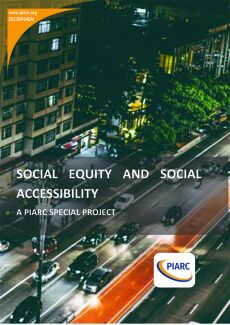
PIARC - World Road Association has established a Special Projects mechanism to respond to emerging issues and priorities identified by its members. In response to this call, this project addressed the issue of ‘Social equity’ and ‘Social accessibility’ for transport projects. The project aimed to capture and analyse the current status quo in terms of how Road Authorities are currently managing social accessibility through their road infrastructure and services, whilst implementing this [...]
-
Managing Innovation in Transport Agencies - PIARC Special Project
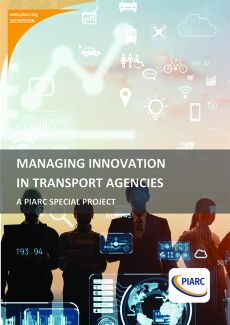
Objectives PIARC commissioned TRL to undertake a research project to identify the ways in which road and transport agencies encourage and sustain innovation, and to identify any lessons that may be learned from other sectors. Specific objectives included identification of internal and external innovation encouragement strategies, understanding of mechanisms to identify and implement and sustain innovations. The project also sought to develop insights into cultivating a culture of innovation, [...]
-
Biking for the Future – Special Project
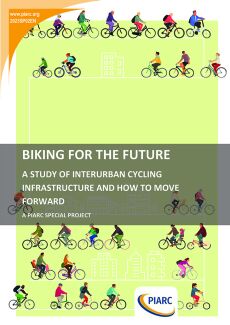
This PIARC Special Project addresses a somewhat overlooked theme; “interurban cycling infrastructure”, that may hold the key to mitigate some of these challenges. We believe that bicycling - often in combination with other means of transportation - has great potential to replace a substantial number of short and mid-range car trips as bicycles are by far the most eco-friendly way of transportation, alongside walking. Investments in active transport modes such as cycling can bring significant [...]
-
PIARC Road Safety Knowledge Exchange - Special Project
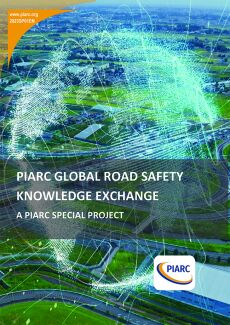
PIARC has an active role in the efforts to improve road safety worldwide through evidence-based studies, technical reports and other type knowledge products. PIARC Technical Committee 3.1 “Road Safety” recognises that 90% of traffic deaths occur in Low- and Middle-Income Countries, and uses this information to assess, identify and share best practices of road safety activities for LMICs through the development of documents and cases studies highlighting international practices and lessons learned. [...]
-
Carbon Neutrality of The Road Sector
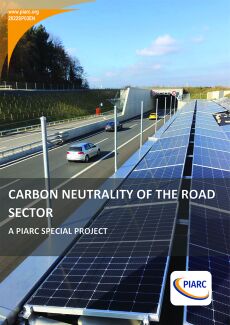
Road transport is vital for society to function and, for the foreseeable future, is expected to remain the dominant mode of transport for people and goods. However, the construction, operation, maintenance and use of the highway infrastructure are responsible for large quantities of carbon emissions. Knowledge of the non-reversible, damaging consequences of climate change has resulted in global acceptance of the need to reduce carbon emissions in all sectors of human activity, including the highways [...]
-
Bridge And Tunnel Strikes By Oversized Vehicles
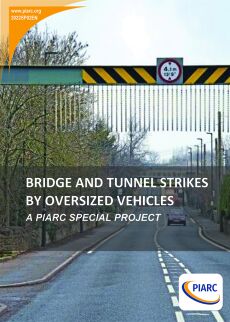
This report details the findings of a study carried out by Roughan & O’Donovan Ltd. (ROD) under the supervision of PIARC, in response to an open call for proposals published by PIARC to conduct the “Bridges and tunnels strikes by oversize vehicles” Special Project. The objective of the study was to examine proven countermeasures, practices, and technologies used to reduce the incidence of oversize vehicles striking bridges and tunnels along with effective processes for accurately reporting [...]
-
Overweight Vehicles: Impact On Road Infrastructure And Safety
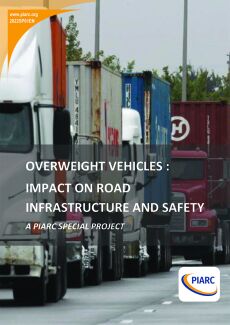
This report compiled the available information on overweight road freight vehicles around the world, the impacts they have on road infrastructure, road safety and the economic position of road infrastructure managers, and collected global best practices to prevent and mitigate overloading. Global experience Weight limits for road freight vehicles typically cover 2 aspects: gross vehicle weight and axle (set) load. Gross vehicle weights differ greatly between countries and continents, from as low [...]
-
Smart Roads Classification
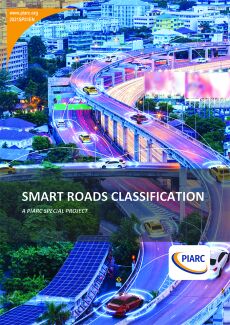
Traditionally, road network classification systems have focused on two fundamentally opposite dimensions: mobility and accessibility. These classification systems have been adapted to the variable circumstances of countries or regions. However, with Connected and Automated Vehicles (CAVs) coming into play, the situation has become quite more challenging than before. Current CAVs consist of diverse Advance Driver Assistance Systems (ADAS) that assist humans in the driving task. The automotive industry [...]
-
Road Related Data and How to Use it
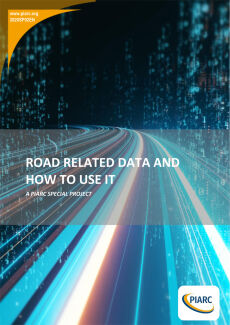
The management of road infrastructure has been experiencing major changes over the past decade, mostly due to the increased demand from road users, the increased deterioration of road infrastructure and from the evolution of user expectations. In addition, new challenges such as climate change and emerging (and potentially disruptive) technologies and service models are changing supply and demand dimensions as well as offering data collection and analytics capability in their own right. This has [...]
-
The Contribution of Road Transport to Sustainability and Economic Development
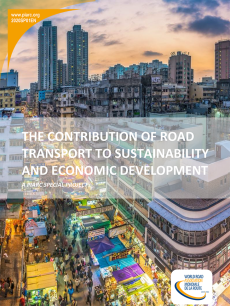
Road transport and road infrastructures are keys to the evolution and prosperity of modern society. Connecting people and places, goods and services in safe, efficient and sustainable way is essential for creating and maintaining sustainable and inclusive growth across society and the economy. This report introduces a constellation of known literature and studies that underline main points, while it refers to a series of interviews with key stakeholders and influencers from the road transport industry. [...]
PIARC Technical Reports on the COVID-19 crisis
-
Summary of the Webinar on Post Covid-19: Planning for Economic Recovery - Briefing Note
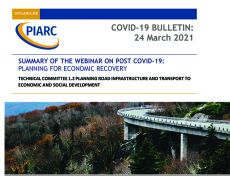
This Bulletin has been prepared by Technical Committee 1.2 on “Planning Road Infrastructure and Transport to Economic and Social Development” of PIARC ( the World Road Association ). The COVID-19 pandemic has accelerated key trends that directly affect transportation and is presenting transportation and transportation planners with an unprecedented set of new challenges and possibilities. This event is unique from past economic downturns because of its scope and scale literally touches [...]
-
Disaster Management: The Effects And Management Of Covid-19 Whilst Looking To The Future - Briefing Note
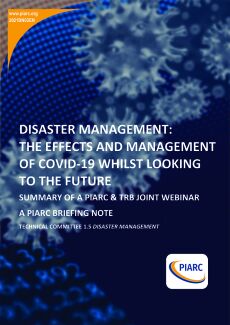
No matter what the disaster is, no matter what the pandemic is, we as road administrators must minimize the disaster impacts to our transportation infrastructure. To share the experiences of disaster management amid COVID-19, PIARC TC 1.5 “Disaster Management” of PIARC and TRB AMR00(2) “Transportation Emergency Management Practices and Innovations Subcommittee” organized a joint webinar on June 30, 2021. The webinar invited six speakers from all over the world. All the presenters reported [...]
-
COVID-19: Survey of Impacts and Responses from the Global Roads and Transport Sector - Briefing Note
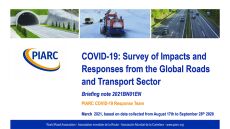
In March 2020, the COVID-19 pandemic took hold across the world, creating massive impacts and challenges for multiple sectors, including roads and transport. PIARC took action rapidly, forming a COVID-19 Response Team and initiating a programme of knowledge-sharing webinars. The Response Team also launched a global questionnaire survey. The intention was to assess how road and transport agencies, operators and other organizations were coping with COVID-19 pandemic and to identify responses and [...]
-
COVID-19: initial impacts and responses to the pandemic from road and transport agencies - Technical Report
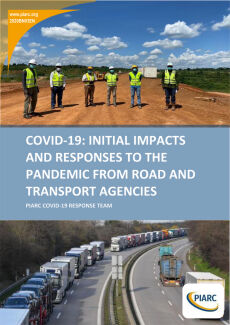
The road transport sector, and the organisations and professionals who manage it, is an essential service and PIARC recognized the potential for COVID-19 to cause severe disruption to the road transport sector early on. In mid-March 2020, PIARC moved to establish a formal PIARC COVID-19 Response Team to explore the rapid sharing of knowledge and practice between PIARC members in terms of pandemic impacts, associated economic and social crisis and the relevant responses. Activities were rapidly launched [...]
-
COVID-19: Key Lessons for the Road and Transport Community from the Latest PIARC Webinars - Briefing Note
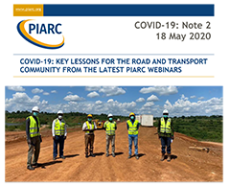
PIARC organizes weekly online discussions on the response to the COVID-19 crisis. They are open to experts appointed by their National PIARC First delegate and to PIARC Technical Committee / Task Force members. The objective of the sessions is to share knowledge and current practice between PIARC members urgently in order to support responses to the pandemic in near real-time.
-
COVID-19: Key Lessons for the Road Community from the first PIARC Webinars - Briefing Note
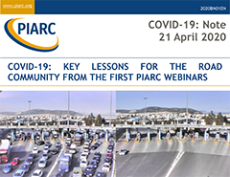
PIARC organizes weekly online discussions on the response to the COVID-19 crisis. They are open to experts appointed by their National PIARC First delegate and to PIARC Technical Committee / Task Force members. The objective of the sessions is to share knowledge and current practice between PIARC members urgently in order to support responses to the pandemic in near real-time.
Cross-Cutting Committees
Road Statistics Committee
-
PIARC DataBook of Road and Road Transport 2020-2023
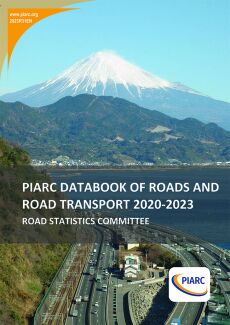
Under the adverse circumstances of COVID-19 spreading across the world, many road administrations have to take further austerity measures while investing in construction of road network, maintaining/rehabilitating existing aged roads, ensuring increased traffic safety and so on. Then they are requested to adequately assess the importance of political measures to be taken and implement them effectively. Also, they should not fail to review the current situation of roads and road transport in an objective [...]